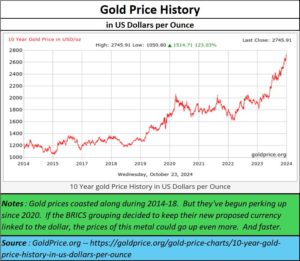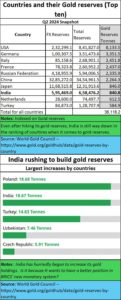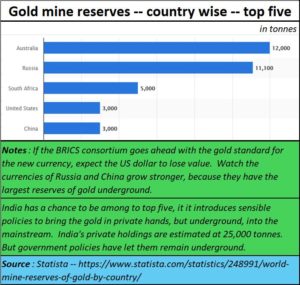BRICS’ gold backed currency could roil the markets
RN Bhaskar
The BRICS conference in Kazan, Russia, from October 22 to 24 2024, is just over. It brought gold centrestage.
BRICS has expanded from the original five – Brazil, Russia, India, China and South Africa. It now includes Egypt, Ethiopia, Iran and the United Arab Emirates (UAE) who joined this year. They were joined by other South East Asian countries Malaysia, Indonesia, Vietnam and Thailand who have also become partner countries of BRICS (https://www.channelnewsasia.com/asia/malaysia-indonesia-vietnam-thailand-brics-asean-global-south-russia-china-4699841). A post on X (formerly Twitter) on Wednesday (Oct 24), the @BRICSInfo account stated that 13 nations have been added to the alliance as partner countries. The other nine nations are Algeria, Belarus, Bolivia, Cuba, Kazakhstan, Nigeria, Turkey, Uganda and Uzbekistan. Applications from a few other countries are being processed.
There is talk, not concluded, of the BRICS creating a separate currency of its own which will be gold-backed. This is to dispense with the constant irritation from the US which has unilaterally removed countries from the global financial exchange known as SWIFT. The new currency would thus render redundant the sanctions imposed by the US.
BRICS is now in a position to create a new body that could first take on the WTO (World Trade Organisation) of the United Nations (Free subscription — https://bhaskarr.substack.com/p/can-india-confront-the-world-of-debt). After all, the world has seen a lot of trade fragmentation ever since the US was the global hegemon (free subscription — https://bhaskarr.substack.com/p/global-fragmentation-new-alignments). Thankfully, that phase is over. It could then – gradually – assume the role that the IMF has carved out for itself, and later – maybe – even the United Nations. Just as the erstwhile League of Nations gave way to a new body, the United Nations may have rendered itself meaningless because of its inability to stand up to the US. The wars in Ukraine and the Middle East are the latest in global disasters that are often being cited as failures of the UN and the US (and the EU as well).
Such talks have spread like wildfire, even as gold prices are burning the circuits almost every day. While they coasted along till 2018, they began climbing from 2020 and began galloping from 2023. Analysts believe that if the gold-backed currency does come into existence, the entire monetary system could be in for an overhaul. And gold prices could scorch everyone’s pocket.
The above table offers some very interesting perspectives:
- The prices of gold rose the highest in Rusia – by 5.5 times. This could be because Russia faced a devaluation crisis in 2014, even though technically, it had recovered from the nasty shocks at the turn of the century when it was on its knees. The credit for rescuing Russia must go to Putin.
- When it comes to debt, the US looks benign. But that would be an illusion. Do remember that the US economy has grown on debt, and today accounts for almost 36% of the global debt of $97 trillion (free subscription — https://bhaskarr.substack.com/p/can-india-confront-the-world-of-debt). What is shocking is that despite high debt levels, it has seen debt double during the past decade. Much of the debt has been to finance wars and destabilise the world. Earlier, it could insulate itself by creating the Petro-dollar. Not now. All the debt will soon roast the US markets domestically.
- China has seen the highest surge in debt – ten times the level of a decade ago. India may take comfort from this because its debt has only doubled. But China’s economy has grown several-fold since then. It has a positive trade balance. And it has wiped out poverty. Its GDP stood at $10.4 bn in 2014, and currently stands at $18,649 bn. In other words, it can be safely said that China’s debt was used productively.
 India’s debt doubled, but its GDP has not gone up much as it should have. Other countries have seen a higher multiple. This suggests that India has not used its debt as productively as China has. The danger is that India could slip into a debt trap if its does not learn to become productive. Its money has been spent unwisely as suggested by the inflation in capital costs (https://bhaskarr.substack.com/p/indias-big-infrastructure-investment) and by the collapse of education (Free subscription — https://bhaskarr.substack.com/p/india-spurns-its-advantages). With a gold backed currency coming into force, it may find itself further marginalised.
India’s debt doubled, but its GDP has not gone up much as it should have. Other countries have seen a higher multiple. This suggests that India has not used its debt as productively as China has. The danger is that India could slip into a debt trap if its does not learn to become productive. Its money has been spent unwisely as suggested by the inflation in capital costs (https://bhaskarr.substack.com/p/indias-big-infrastructure-investment) and by the collapse of education (Free subscription — https://bhaskarr.substack.com/p/india-spurns-its-advantages). With a gold backed currency coming into force, it may find itself further marginalised.
India appears to have realised that its gold holdings were too low. Maybe its policymakers had heard whispers about a gold-backed currency that BRICS would like to introduce. That could explain why India was one of the biggest purchasers of gold last year – at least among central governments.
But some strengths have not yet been understood by many. While the US may have the largest gold reserves in vaults, watch Russia and China which still have much of their gold underground. They will excavate it when the time is right.
That could make them the money drivers of the global economy.
The US with its debt burden will have to find new ways to deal with its debt. The wars it has provoked in Europe and the Middle East are not helping it in any way. The new war strategies that have unfolded in both Europe and the Middle East make much of the arms industry – led by the US – redundant and even obsolete. The two big revenue earners for the US are the arms/defence industry and oil. The first is already scrambling for cover – its weapons have been outmatched in both war theatres. Its oil could be swamped with new output from a revitalised Iran and Russia.
It won’t be just Israel which will bleed from a thousand cuts.
Ideally, India should work very closely with Russia to let its labour work on the latter’s gold mines on a production-sharing basis just as it does with Rusia’s oil sector. It won’t be easy, because Russia does not like foreigners on its soil. But given the right legal framework of building labour camps and with strict policies of not mingling with local populations (as Saudi Arabia has done), it might be possible. This author had made this suggestion time and again since 2009 (https://www.livemint.com/Companies/wDLWbd3OWUGppEzYYC0yYO/The-Capitalist–With-increasing-water-needs-will-China-deh.html), but the government’s bureaucrats seem too beholden to the US to push the Russia-China collaboration (free subscription — https://asiaconverge.com/2024/09/india-china-and-russia-could-be-dancing-together-finally/).
However, the world is changing rapidly. Russia and China are likely to call the shots. India could have, but its policies – more along ideological lines than on economic justification – have hobbled it.
It needs to wake up the new realities and work on gold and new relationships – including with ASEAN countries (free subscription — https://bhaskarr.substack.com/p/india-china-and-russia-could-be-dancing). And it needs to focus on improving its human capital so that it can be made more productive.
The days of chest thumping appear to be coming to an end. The real work begins now.
======================
Do watch my latest podcast on Religion, Values and the Economy at https://youtu.be/jf02UqgXVEY
=============================










































COMMENTS